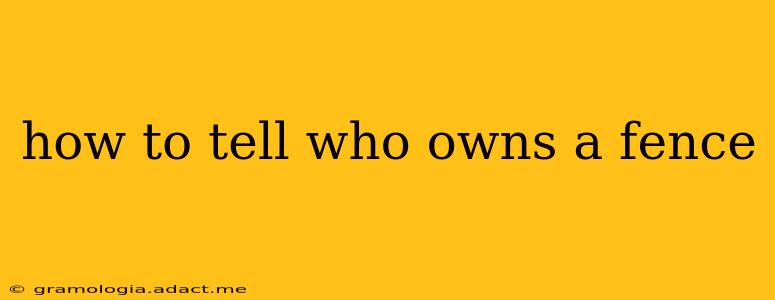Determining fence ownership can be surprisingly tricky, varying significantly depending on location, local laws, and the fence's specific circumstances. This guide will equip you with the knowledge and strategies to navigate this common property dispute effectively. Knowing who owns a fence is crucial for maintenance, repairs, and resolving potential disagreements with neighbors.
How to Find Out Who Owns the Fence: Practical Steps
The first step is always to try and talk to your neighbor. A friendly conversation is often the most efficient way to resolve the issue. However, if that proves unsuccessful or if the neighbor is unresponsive, here are several avenues to explore:
1. Check Your Property Deeds and Survey:
Your property deed, a legal document outlining your land boundaries, should explicitly state the location of property lines and, ideally, any easements or agreements regarding fences. A survey conducted by a licensed surveyor will definitively mark your property boundaries, leaving no room for ambiguity concerning fence ownership. This is the most reliable method for determining ownership.
2. Review Local Ordinances and Zoning Laws:
Municipal laws often regulate fence construction and maintenance. These ordinances may dictate who is responsible for maintaining a fence based on its location relative to property lines. Contact your local government's planning or zoning department to access these regulations.
3. Examine the Fence Itself:
While not definitive, inspecting the fence might offer clues. Look for:
- Maintenance patterns: Who regularly maintains the fence (mowing, painting, repairs)?
- Materials: If the fence was constructed recently, you might be able to track down the contractor who built it. Their records might show who commissioned the work.
- Visible property markers: Some property markers might be visible near the fence line.
4. Consult with a Real Estate Attorney:
If you're having trouble determining ownership, a real estate attorney is your best resource. They can interpret property deeds, zoning laws, and advise you on the legal steps to take to resolve the dispute.
Frequently Asked Questions (FAQs)
Here are some common questions surrounding fence ownership:
What if the fence is on the property line?
If a fence sits directly on the property line, shared ownership is usually implied, unless otherwise stipulated in property deeds or agreements. Both neighbors typically share responsibility for maintenance and repairs. The specific responsibilities can be defined in a written agreement.
Who is responsible for fence repair?
Responsibility for fence repair depends heavily on ownership. If you own the fence, you are responsible for its upkeep. If it's a shared fence, responsibilities can be divided equally or according to a prior agreement.
What if my neighbor refuses to cooperate on fence repairs?
If your neighbor refuses to cooperate in repairing a shared fence, consulting a real estate attorney is crucial. They can advise you on legal options, including mediation or potentially filing a lawsuit.
Can I legally remove a fence that is not mine?
No, removing a fence that doesn't belong to you is generally illegal, even if it encroaches on your property. Always attempt to resolve the issue peacefully, ideally with the neighbor's agreement. Consulting legal counsel is recommended before taking any action.
What if the fence is old and its ownership is unclear?
For older fences, establishing ownership can be challenging. Reviewing old property records, talking to long-term neighbors, and consulting a surveyor or attorney can help shed light on the fence’s history and ownership.
Conclusion:
Determining fence ownership requires a systematic approach. Start with a friendly conversation, then consult your property documents and local regulations. If those methods fail, seeking professional legal advice is crucial for protecting your rights and resolving the issue fairly. Remember, proactive communication and documentation are key to avoiding disputes and maintaining positive relationships with neighbors.
